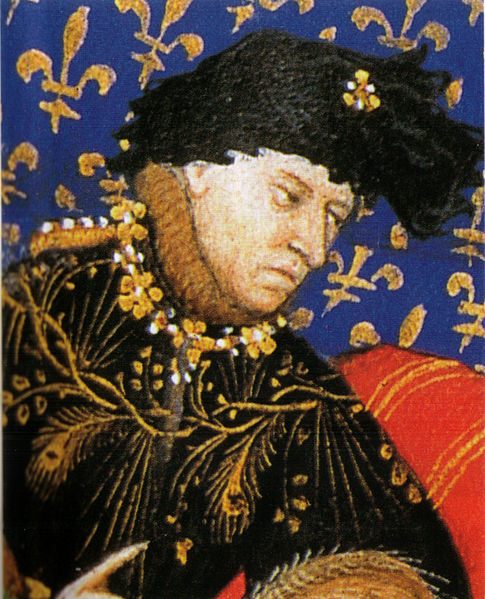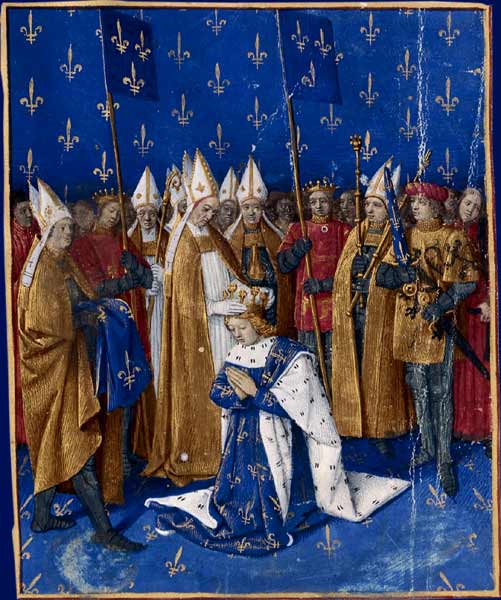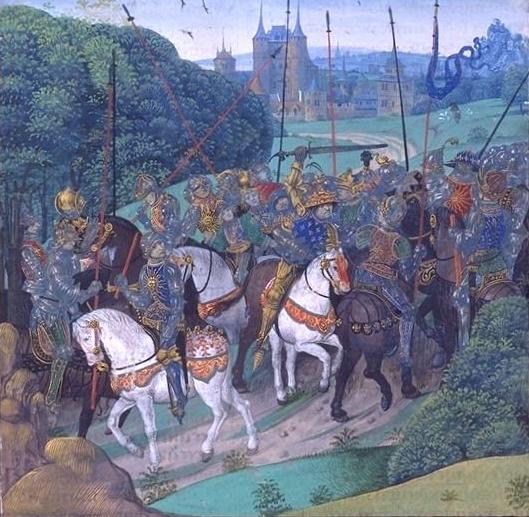<Back to Index>
- Chemist Ellen Henrietta Swallow Richards, 1842
- Writer Ludvig Holberg, 1684
- King of France Charles VI, 1368
PAGE SPONSOR


Charles VI (3 December 1368 – 21 October 1422), called the Beloved (French: le Bien-Aimé) and the Mad (French: le Fol or le Fou), was the King of France from 1380 to 1422, as a member of the House of Valois. His periods of madness, which seem to have begun in 1392, led to quarrels among the French royal family, which were exploited by the neighbouring powers of England and Burgundy. By the end of his reign much of France was under foreign occupation.
He was born in Paris, the son of King Charles V and Joan of Bourbon. At the age of eleven, in 1380, he was crowned King of France in the cathedral at Reims. He married Isabeau of Bavaria in 1385. Until he took complete charge as king in 1388, France was ruled primarily by his uncle, Philip the Bold, Duke of Burgundy. During that time, the power of the royal administration and the authority to tax was reestablished, following the tax revolt known as the Harelle, after his father had repealed the taxes on his deathbed.
Charles VI was known both as Charles the Beloved and later as Charles the Mad, since, beginning in his mid twenties, he experienced bouts of psychosis. These fits of madness would recur for the rest of his life. Based on his symptoms, he probably suffered from schizophrenia. Charles's first known fit occurred in 1392 when his friend and advisor, Olivier de Clisson, was the victim of an attempted murder. Although Clisson survived, Charles was determined to punish the would be assassin Pierre de Craon who had taken refuge in Brittany.
Contemporaries said Charles appeared to be in a "fever" to begin the
campaign and appeared disconnected in his speech. Charles set off with
an army on 1 July 1392. The progress of the army was slow, nearly
driving Charles into a frenzy of impatience. As
the king and his escort were travelling through a forest on a hot
August morning, a barefoot leper dressed in rags rushed up to the
King's horse and grabbed his bridle. "Ride no further, noble King!" he
yelled. "Turn back! You are betrayed!" The king's escorts beat the man
back but did not arrest him, and he followed the procession for a
half hour, repeating his cries. The
company emerged from the forest at noon. A page who was drowsy from the
sun dropped the king's lance, which clanged loudly against a steel
helmet carried by another page. Charles shuddered, drew his sword and
yelled "Forward against the traitors! They wish to deliver me to the
enemy!" The king spurred his horse and began swinging his sword at his
companions, fighting until one of his chamberlains and a group of
soldiers were able to grab him from his mount and lay him on the
ground. He lay still and did not react, but fell into a coma. The king
had killed a knight called "The Bastard of Polignac," and several other
men, the number of which varies among contemporary chronicles.
The
king continued to suffer from periods of mental illness throughout his
life. During one attack in 1393, Charles could not remember his name
and did not know he was king. When his wife came to visit, he asked his
servants who she was and ordered them to take care of what she required
so that she would leave him alone. During
an episode of 1395 - 1396, he claimed that his name was George and that
his coat of arms was a lion with a sword thrust through it. At
this time, he recognized all the officers of his household but did not
know his wife or his children. Sometimes he ran wildly through the
corridors of his Parisian residence, the Hôtel Saint-Pol, and to
keep him inside, the entrances were walled up. In 1405, he refused to
bathe or change his clothes for five months. His
later psychotic episodes were not described in detail probably because
of the similarity of his behavior and delusions. Pope Pius II, who was
born in the middle of the reign of Charles VI, wrote in his Commentaries that
there were times when Charles thought that he was made of glass, and
this caused him to protect himself in various ways so that he would not
break. This condition has come to be known as glass delusion.
On
29 January 1393, at the behest of the king, a grand party was organized
to celebrate the wedding of one of the queen's ladies - in - waiting at the
Hotel de Saint Pol. At the suggestion of a Norman Squire, Huguet de
Guisay, the King and four other lords dressed up as wild men and
danced about chained to one another. They were "in costumes of linen
cloth sewn onto their bodies and soaked in resinous wax or pitch to
hold a covering of frazzled hemp, so that they appeared shaggy &
hairy from head to foot". At
the suggestion of one of the "wild men," Yvain de Foix, the king
commanded - in view of the obvious danger of fire - that the
torch bearers were to stand at the side of the room. Nonetheless, the
King's brother, Louis of Valois, Duke of Orléans,
who had arrived late, approached with a lighted torch in order to
discover the identity of the masqueraders, and he accidentally set one
of them on fire. Alternatively, it may have been a plot to kill the
mentally deficient king. In any case, there was panic as the fire
spread. The Duchess of Berry,
to save a dancer who had come near her to intrigue and tease her, threw
the train of her gown over him, and it was soon revealed to her that
the life she had saved was the king's. Several Knights who tried to put out the flames were severely burned on their
hands. Four of the wild men perished: Sir Charles de Poiters son of the Count of Valentinois, Huguet de Guisay, Yvain de Foix and the Count of Joigny. Another, Jean son of the Lord de Nantouillet, saved himself by jumping into a dishwater tub. This incident became known as the Bal des Ardents (the "Ball of the Burning Men").
With the King mad, his uncles Philip the Bold, Duke of Burgundy, and John, Duke of Berry,
took control and dismissed Charles's advisers and various officials he
had appointed. Another contender for power was the King's brother, Louis I de Valois, Duke of Orléans.
This was to be the start of a series of major feuds among the princes
of royal blood which would cause much chaos and conflict in France even
beyond Charles's reign. The
first major feud was between Philip the Bold and Louis, duke of
Orléans who both tried to fill the power vacuum left by the
King's condition. Philip's death in April 1404 did not bring an end to
Louis's problems. John the Fearless, the new Duke of Burgundy took
over and the feud escalated. In 1407, the Duke of Orléans was
murdered in the streets of Paris. John did not deny responsibility,
claiming that Louis was a tyrant who squandered money. Louis's son, Charles, new Duke of Orléans, turned to his father - in - law, Bernard VII, Count of Armagnac, for support. This resulted in the Armagnac - Burgundian Civil War. Charles
VI's secretary, Pierre Salmon, spent much time in discussions with the
king while he was suffering from his intermittent but incapacitating
psychosis. In an effort to find a cure for the king's illness,
stabilize the turbulent political situation, and secure his own future,
Salmon supervised the production of two distinct versions of the
beautifully illuminated guidebooks to good kingship known as Pierre
Salmon's Dialogues. Charles VI's reign was marked by the continuing conflict with the English known as the Hundred Years' War. An early attempt at peace occurred in 1396 when Charles's daughter, the almost seven year old Isabella of Valois, married the 29 year old Richard II of England. By
1415, however, the feud between the Royal family and the house of
Burgundy had led to chaos and anarchy throughout France. Taking
advantage, Henry V of England led an invasion which culminated in October when the French army was defeated at the Battle of Agincourt.
With the English taking over the country, John the Fearless sought to
end the feud with the Royal family by negotiating with the Dauphin, the King's heir. They met at the bridge at Montereau on 10 September 1419 but during the meeting, the John was killed by Tanneguy du Châtel, a follower of the Dauphin. John's successor, Philip the Good, threw in his lot with the English. (Philip the Good would later make peace with the Dauphin, now Charles VII, with the Treaty of Arras when, under the inspiration of Joan of Arc, the tide of the war turned in favour of the French. Joan was burned at
the stake when Burgundy handed her over to the English.) In 1420, King Charles signed the Treaty of Troyes which recognized Henry of England as his successor, disinherited his son, the Dauphin Charles, and betrothed his daughter, Catherine of Valois, to Henry.
Many
historians have misinterpreted this treaty and the disinheriting of the
Dauphin Charles. The Dauphin sealed his fate, in the eyes of the king,
by committing treason: he declared himself regent, usurping royal
authority, and refused to obey the king's order to return to Paris. It
is important to remember that when the Treaty of Troyes was finalized
in May 1420, the Dauphin Charles was only 17 years old. He was then a
weak figure who was easily manipulated by his advisors. Charles VI died in 1422 at Paris and is interred with his wife Isabeau de Bavière in Saint Denis Basilica. Both their grandson, the one year old Henry VI of England, and their son, Charles VII, were proclaimed King of France, but it was the latter who became the actual ruler with the support of Joan of Arc. Charles
VI appears to have passed on his mental illness to his grandson Henry,
whose inability to govern led England to a civil strife of its own
known as the Wars of the Roses.
